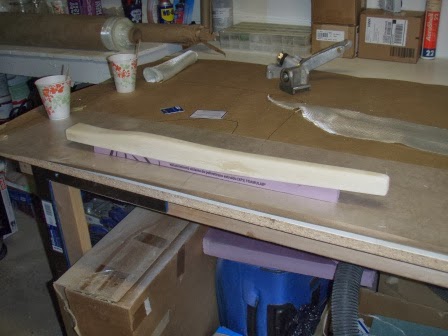The first step is to sand the strut so that all the castings fit. Notice here how the casting does not fit... the strut is purposely made over-sized so you can sand it down to a custom fit.
The entire strut was sanded dull and smoothed - the edges were rounded to allow the fiberglass to wrap around smoothly. I then propped the strut on top of a scrap foam piece (to allow the glass to overhang while curing).
I then painted plain epoxy on the back face and side walls to assure a good bond and reduce any unwanted air bubbles.
I then applied 1 ply BID at 45 degree bias... poured epoxy over it and wetted it out.
I made sure the 1 ply conformed to the shape of the strut and that no air bubbles were present.
After letting it cure overnight, I used a blade knife to cut the overhang off.
I then sanded the edges round and prepped the front side of the strut for its 1 ply of BID.
Again, I propped it up on a scrap foam and painted plain epoxy on the front face and side walls.

I then applied the 1 ply BID and made sure the cloth conformed to the strut's shape...
Poured epoxy over it...
... and wetted it out..
After cure, I trimmed the overhang...
And fine trimmed with a blade knife...
I then sanded the entire strut nice and smooth...
The nose strut is now ready for the castings... stay tuned!

















2 comments:
Noob question; if the strut comes prefabricated, what is the purpose of applying another layer of glass cloth?
(Really, really enjoying watching your progress on this blog, by the way. Keep it up!)
Thank you for the positive comments!
To answer your question, both the main strut and nose gear strut are made out of 'S' glass in a mold. Most home-builders don't have access to molds, and even if they did, don't have an autoclave to cure the parts. So the term "prefabricated" is loosely used here. Only the core of the strut is prefabricated and purchased.
The plans then have you wrap the core in fiberglass which adds a layer of protection (keeps the core from nicks and splitting) and also helps stiffen it up.
It's not cost effective for the strut manufacturer to also add the reinforcement plies for the builder.
I hope this answers your question. Let me know if you have any others!
-Ary
Post a Comment